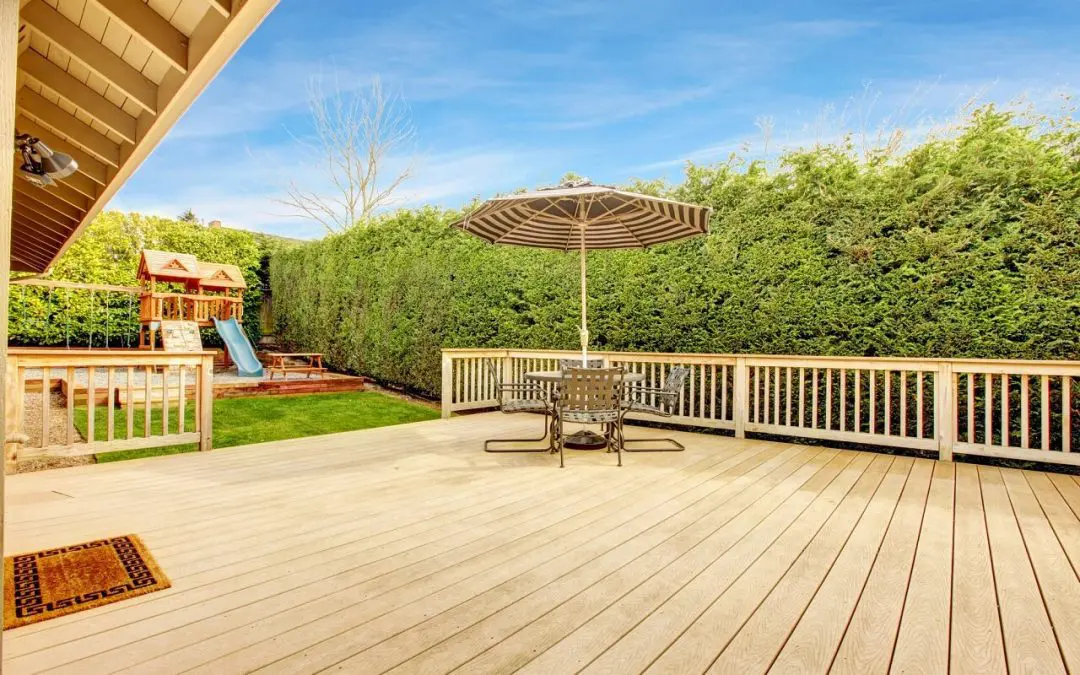Picking a decking material isn’t easy when building a deck. There are numerous options available, each with its unique pros and cons. Before you settle on a material, here are some of the most popular decking materials to consider using to build your deck.
Pressure-Treated Lumber Decking Materials
Pressure-treated wood is the most common decking material. It is typically made of pine, and it’s chemically treated to make it resistant to pests and decay.
Pros
- It’s inexpensive compared to other decking materials.
- It has a long lifespan of 15 to 20 years.
- It’s readily available at most hardware and home improvement stores.
- It’s easy to cut and work with.
Cons
- Pressure-treated lumber needs to season for six months before sealing it.
- It requires regular power washing, re-staining, and sanding to keep it in good condition.
- The wood can splinter, warp, and crack.
Cedar and Redwood Decking Materials
Cedar and redwood are excellent alternatives to pressure-treated wood that offer the traditional appearance of a wooden deck.
Pros
- Cedar and redwood protect against rot and insects due to their natural oils.
- Cedar and redwood decks can last up to 20 years.
- Redwood and cedar decks increase your home’s value.
Cons
- Cedar and redwood cost more than pressure-treated lumber.
- Both kinds of wood are light, making them great for DIY projects.
- Cedar and redwood decks require regular power washing, sanding, and refinishing to keep them in excellent shape.
- As softwoods, they are prone to scratches and dents.
Tropical Hardwood Decking Materials
Tropical hardwoods are the most premium option among the wood decking materials.
Pros
- Tropical hardwood decks have a long lifespan of up to 50 years.
- They are resistant to pests and decay.
- Tropical hardwoods age better compared to softwoods.
Cons
- Tropical hardwoods are pricier than other wood options.
- Tropical hardwoods are challenging to work with, making them unsuitable for DIY projects.
- Tropical hardwoods aren’t as readily available as the other wood decking options.
Aluminum Decking Materials
Aluminum is a modern decking material that provides an industrial look.
Pros
- An aluminum deck can last for up to 50 years.
- Aluminum is resistant to mold, pests, and elements.
- It requires minimal maintenance.
- Aluminum doesn’t fade, unlike other decking options.
Cons
- Aluminum is costlier than other decking materials.
- It can be loud when there’s heavy rain.
Composite Decking Materials
Composites are an environmentally friendly decking material because they’re made from recycled materials. Their appearance resembles wood.
Pros
- Composites are lightweight and easy to work with.
- They are easy to maintain.
- They have a long lifespan of up to 50 years.
Cons
- Composites must be cleaned regularly to prevent the growth of mold and mildew.
- Composites are costlier than most wood options.
- Composites aren’t easy to work with, and they can sag if not installed correctly.
Plastic Decking Materials
Plastic decking materials are usually PVC or polyethylene, providing a durable surface.
Pros
- Plastic is splinter-free.
- It doesn’t require staining, sealing, or refinishing.
- It’s lightweight and easy to work with, making it ideal for DIY projects.
Cons
- Plastic decks can warp or sag if it gets scorching hot.
- Plastic decks have a synthetic feel, and some can look cheap.
- Some plastic decks are slippery.
These six decking options are great options to consider. However, consider cost, ease of installation, maintenance, lifespan, and your preference before choosing a material.
Carolina HomePro Inspections provides inspections to customers in Charlotte, NC, and in the Rock Hill area of South Carolina. Contact us to schedule an inspection.

